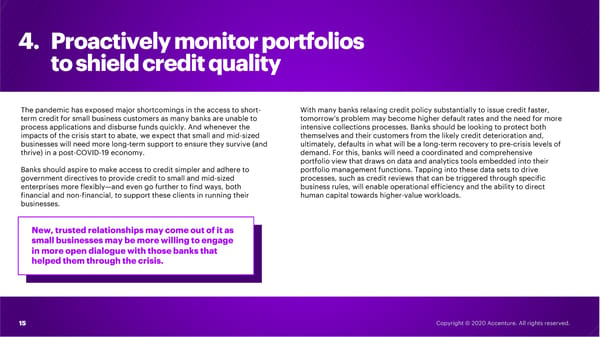4. Proactively monitor portfolios to shield credit quality The pandemic has exposed major shortcomings in the access to short- With many banks relaxing credit policy substantially to issue credit faster, term credit for small business customers as many banks are unable to tomorrow’s problem may become higher default rates and the need for more process applications and disburse funds quickly. And whenever the intensive collections processes. Banks should be looking to protect both impacts of the crisis start to abate, we expect that small and mid-sized themselves and their customers from the likely credit deterioration and, businesses will need more long-term support to ensure they survive (and ultimately, defaults in what will be a long-term recovery to pre-crisis levels of thrive) in a post-COVID-19 economy. demand. For this, banks will need a coordinated and comprehensive portfolio view that draws on data and analytics tools embedded into their Banks should aspire to make access to credit simpler and adhere to portfolio management functions. Tapping into these data sets to drive government directives to provide credit to small and mid-sized processes, such as credit reviews that can be triggered through specific enterprises more flexibly—and even go further to find ways, both business rules, will enable operational efficiency and the ability to direct financial and non-financial, to support these clients in running their human capital towards higher-value workloads. businesses. New, trusted relationships may come out of it as small businesses may be more willing to engage in more open dialogue with those banks that helped them through the crisis. 15 Copyright © 2020 Accenture. All rights reserved.
 Navigating COVID-19: Commercial Banks Page 14 Page 16
Navigating COVID-19: Commercial Banks Page 14 Page 16